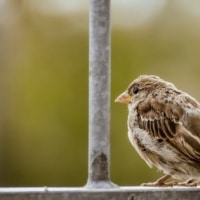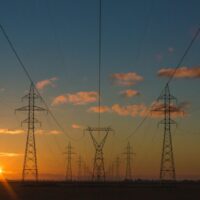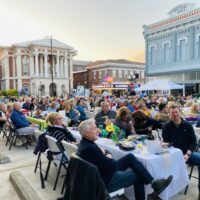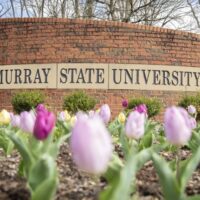Collectable Barbie dolls, bowling balls and scrapbooks. Boats, barges, cars, shoes and dock floats. Bottles and styrofoam beads. Even a disco ball. These are just some of the things found in and around Kentucky Lake by cleanup crews in the wake of December’s tornado outbreak.
The damage assessment and cleanup of Land Between the Lakes National Recreation Area (LBL) is still ongoing almost three months after the disaster.
Two tornadoes hit LBL on Dec. 10 — one on the northern end, which also hit Mayfield and Dawson Springs, and the other on the southern end that went on through parts of Tennessee. LBL Public Affairs Officer Scott Raymond said while LBL doesn’t have numbers on how many acres were affected or how many trees were damaged, it is “pretty extensive.”
“It takes months to be able to fully understand what it did to the landscape, how it’s going to affect the ecosystem and things that make LBL such a special place,” Raymond said.

Crews are already out doing evaluations of damaged trees and landscapes to decide on the next steps for recovery. Raymond said so far LBL has not found severe damage to its facilities. There is a section of the North/South Trail that is closed and they’re expecting the assessments to show damage to some of the campgrounds.
“Keeping visitors’ safety in mind, we’re doing our absolute best to ensure that those places are attended to and fixed up,” Raymond said.
Opening weekend for LBL is coming up at the beginning of April. Raymond said LBL is taking every opportunity to ensure that visitors aren’t impacted by tornado damage during their visit.
One of the ways that LBL is recovering from the tornado damage is with shoreline cleanups. Friends of Land Between of Lakes, a volunteer organization that helps LBL with a variety of things such as programs and funding, has done two shoreline cleanups so far this year. Friends of LBL even did a cleanup with Living Lands and Waters, a nonprofit organization dedicated to river cleanup. LLW has been working with Marshall County officials and the Tennessee Valley Authority throughout this process.
The Quad Cities-based nonprofit works on and around the different river systems of the Mississippi River. They also do invasive species removal projects, alternative spring breaks and tree planting projects. Callie Schaser, a communications specialist with Living Lands and Waters, said the group of about seven or eight people assigned to Kentucky Lake has been out and cleaning almost seven days a week since Dec. 23.
The group has a fleet of ships and barges they use for cleanups, and they even live on one of the barges for much of the year. One of the barges has an excavator on it to pull trash off the shoreline and onto the different barges.
“That’s what we have brought to Kentucky Lake,” Schaser said. “We can go around and clean up those big items that our hands aren’t able to get, and then we also go up and down and around the shores in our 30 foot John boats that we have.”
LLW uses the country’s waterways to do disaster cleanup. The organization is uniquely equipped because it has the ability to travel to different locations on the water and its barge excavator can pick up items from the water that other groups might not be able to get to.
“We can go out and pick them up in thousands of pounds and put them onto our barge, and then offload them somewhere as well to either get scrapped or to get disposed of properly,” Schaser said.
LLW’s team has been working out of the Rocky Point Boat Launch. The focus has been on the Cambridge Shores area and the LBL side of Kentucky Lake. LLW couldn’t get its barges over to the Lake Barkley side of LBL. Cambridge Shores was almost completely destroyed by the tornado outbreak and the pathway included lots of damaged boats, cars and docks. The area is generally a vacation home destination.
“Fortunate for where the tornado hit and when, it was a Friday so it would have been crazy if it was during the actual tornado season,” Schaser said. “But luckily not everybody was at their home, so that’s a really good way to think about how much destruction you’ll see was through here and people already started rebuilding and stuff. If they were here, everybody here would have died. It’s that bad of how it just destroyed (the area is).”
When LLW arrived, the team wasn’t sure what public lands that they could access or if other organizations might be coming in, so Schaser said they went door to door in the Cambridge Shores area and offered help.
“We made those relationships with them, and we had a whole spreadsheet of ‘All right, Jim in 402 needs this done or don’t touch this yet. He wants to salvage this or she wants to salvage that or she called she lost a safe — do we see a safe?’ Or just anything,” Schaser said. “We’ve connected with the community when we go out because we lived here for now two months and become little locals and everybody knows, they’re like, ‘You’re not from here, but what are you doing?’ And we’ll tell them, and they’re like, ‘Oh, like thank you so much,’ and they’re just super appreciative of what we’re doing.”
So far, LLW has removed at least 1.2 million pounds of debris during this cleanup. Schaser said that’s a cautious estimate.
“Besides the barge going around and the excavator and picking up those big items, you also have our crew members going out in our John boats and going up and down the shores and stacking piles of wood and different lumber because there’s tons of males in it,” Schaser said. “As soon as those water levels rise up, all of the stuff that was left from damage and everything and styrofoam is all going down into the lake, and it can be so dangerous for the summertime.”
Schaser estimated that just the wood being pulled out of the water was 400,000 to 500,00 pounds alone. Some of the wood materials being pulled out is composite wood from decks, which is heavier than regular driftwood and dimensional lumber.
They’re also picking up lots of plastic dock floats. Most of the dock floats are large pieces of plastic filled with large pieces of styrofoam. The styrofoam gets heavier when it’s wet. Additionally, the styrofoam is beaded and so even when LLW gets large pieces out, they’re leaving behind lots of little beaded pieces that will eventually wash up on the shoreline.
To compare, in a regular year of river cleanups, Schaser said they pick up about 500,00 to 600,000 pounds of trash and debris.
LLW wants to get everything cleaned up before people start coming in for the spring and summer. The debris, specifically items like boards with nails, can be dangerous for people just trying to enjoy their time on the lake. Additionally, the debris is dangerous for the wildlife in the area. They’re also in a race against the rising water levels as it warms up.
“We’ve had crews kind of coming in and out,” Schaser said. “We’ve gotten some help from volunteers and different groups coming in to help us because we really just need hands at this time when we’re getting the smaller pieces of wood that concrete splinters but there’s just so many nails in the boards.”
LLW has worked with an AmeriCorps NCCC group, the Friends of LBL and other volunteer groups.
The organization doesn’t normally pick up nature-made things like driftwood and downed trees. They mostly focus on the man-made debris. However, with this clean up, LLW is picking up things like dimensional lumber because of the risks this time.
The trees damaged by the tornado are being assessed by specialized crews from the United States Forest Service. Some of the trees that were damaged by the storm were twisted, split or exploded. Carlin Lewis, a public affairs specialist for LBL, said the goal of the specialists is to provide safe operations for LBL.
“At this part in our recovery, we’re preparing for tornado damage timber cleanup and salvage sales,” Lewis said.
The salvage sales and timber cleanup are a part of the forest management tools the National Forest Service uses to help areas impacted by storms like the December tornado outbreak recover safely, and possibly more resilient and productively.
“We have to act quickly though when we assess the damaged timber,” Lewis said. “It does degrade pretty quickly and deteriorate because these trees are heavily damaged and a lot of them are dead.”
Removing these trees quickly will help limit sources for insects, fungus or wildfires. It could also help improve the habitat, increase open lands or increase the potential for native plants in LBL, Lewis said. The salvage sales themselves will also help provide goods and services to local communities since the revenue will be going back into LBL to provide support for projects.
Visiting foresters from Shawnee National Forest and the U.S. Forest Service is still mapping, measuring and calculating the damage in LBL. The groups are also marking the areas of damaged wood for potential sales.
The downed trees need to be disposed of as quickly as possible because the longer they sit and decay, the more dangerous they are to remove. Lewis said there isn’t a specific target date for getting all the damaged trees in LBL removed.





